In today’s rapidly changing work landscape, remote work has emerged as a popular working model, offering employees increased flexibility.
In this article, we’ll cover the latest statistics on remote work prevalence, benefits, and challenges of remote work.
General Remote Work Statistics and Trends
Around 1 in 4 employees in the US work remotely at least some hours (BLS)
As of March 2025, 22.8% of US employees worked remotely at least partially, which accounts for 36.07 million people.
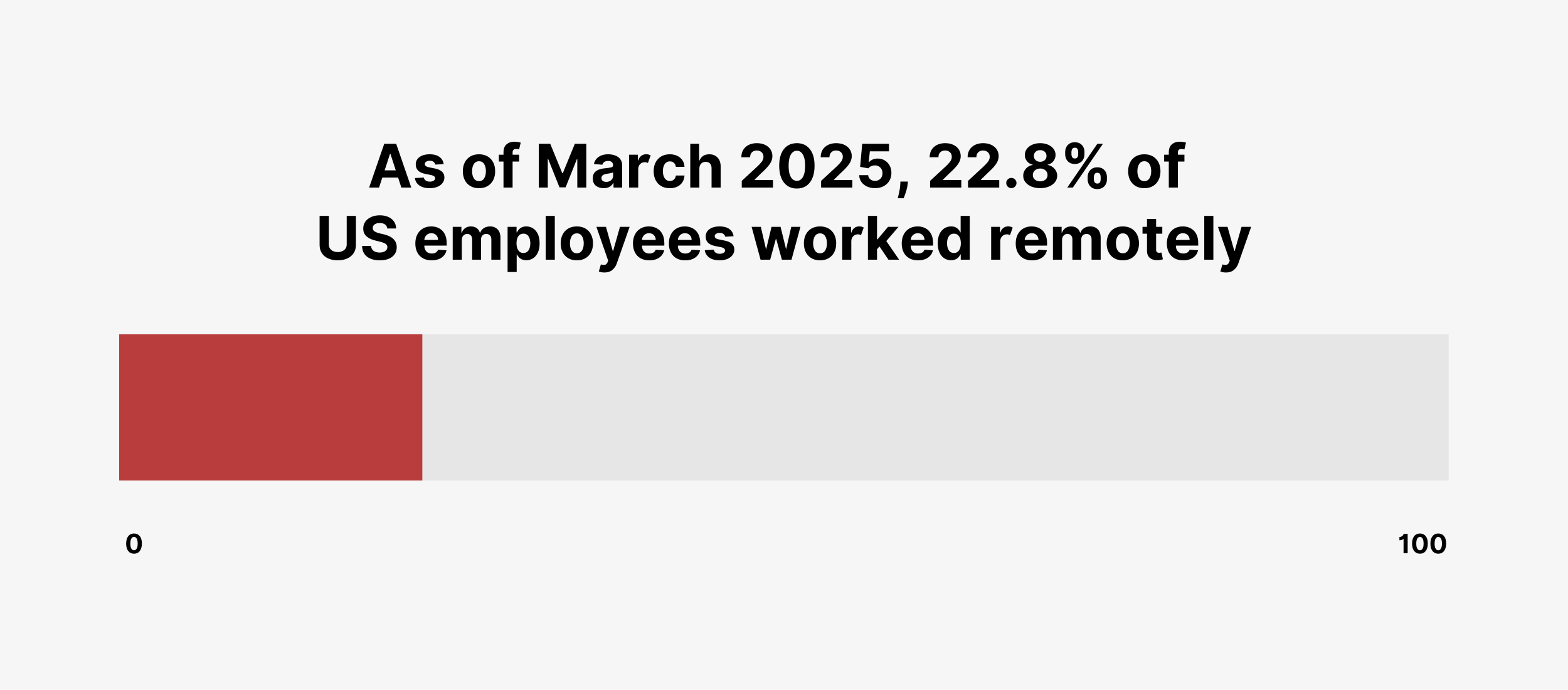
Here’s a table with a share of US employees working remotely since January 2024:
| Date | Share of US Employees Working Remotely |
|---|---|
| January 2024 | 22.9% |
| February 2024 | 22.7% |
| March 2024 | 23.0% |
| April 2024 | 21.5% |
| May 2024 | 21.7% |
| June 2024 | 22.3% |
| July 2024 | 23.0% |
| August 2024 | 22.8% |
| November 2024 | 23.3% |
| February 2025 | 22.8% |
Nearly half of US employees with an advanced degree work remotely (BLS)
42.8% of American employees with an advanced degree did telework in March 2025. To put in perspective, only 9.1% of employees who are high school graduates with no college degree worked remotely in the same month.
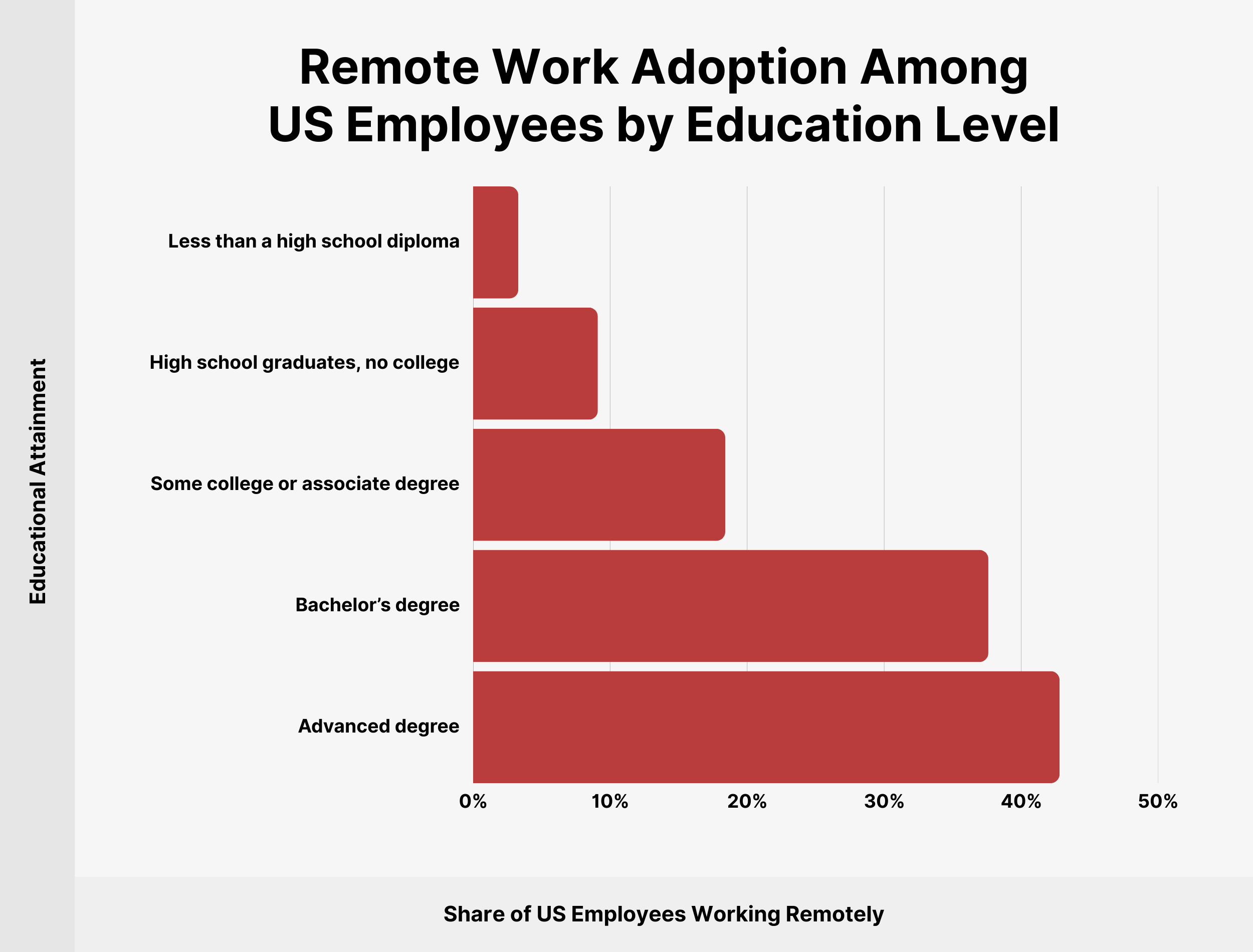
There’s a clear connection between education levels and remote work adoption rates.
Here’s a detailed breakdown of remote work adoption among US employees by education level:
| Educational Attainment | Share of US Employees Working Remotely |
|---|---|
| Less than a high school diploma | 3.3% |
| High school graduates, no college | 9.1% |
| Some college or associate degree | 18.4% |
| Bachelor’s degree | 37.6% |
| Advanced degree | 42.8% |
The largest share of remote employees falls within the age range of 35 to 44 years (BLS)
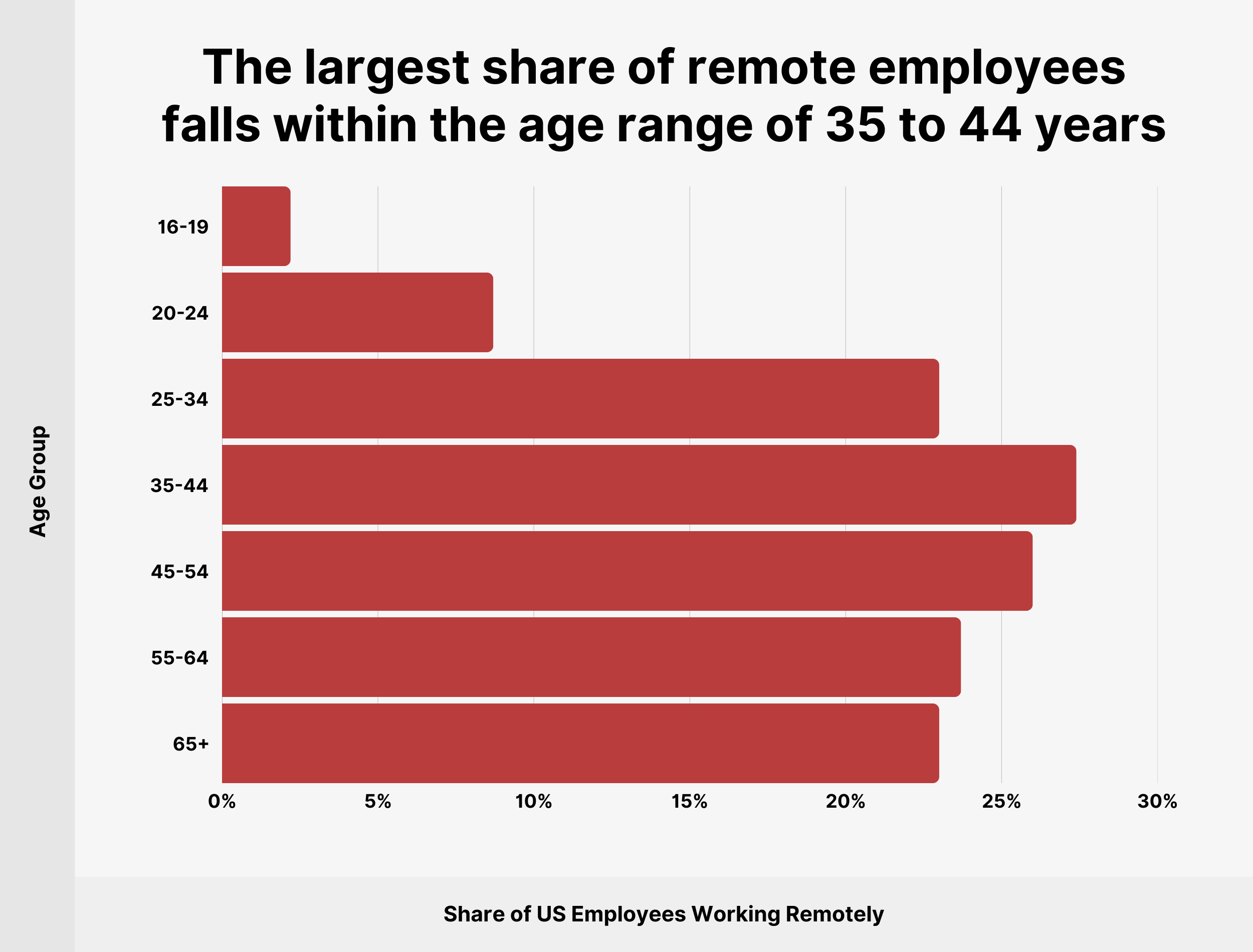
Those aged 35 to 44 are most likely to work remotely. Within this demographic, 27.4% work at least some hours remotely.
| Age Group | Share of US Employees Working Remotely |
|---|---|
| 16-19 | 2.2% |
| 20-24 | 8.7% |
| 25-34 | 23.0% |
| 35-44 | 27.4% |
| 45-54 | 26.0% |
| 55-64 | 23.7% |
| 65+ | 23.0% |
28.7% of employees currently work remotely or in hybrid mode (Survey of Business Uncertainty)
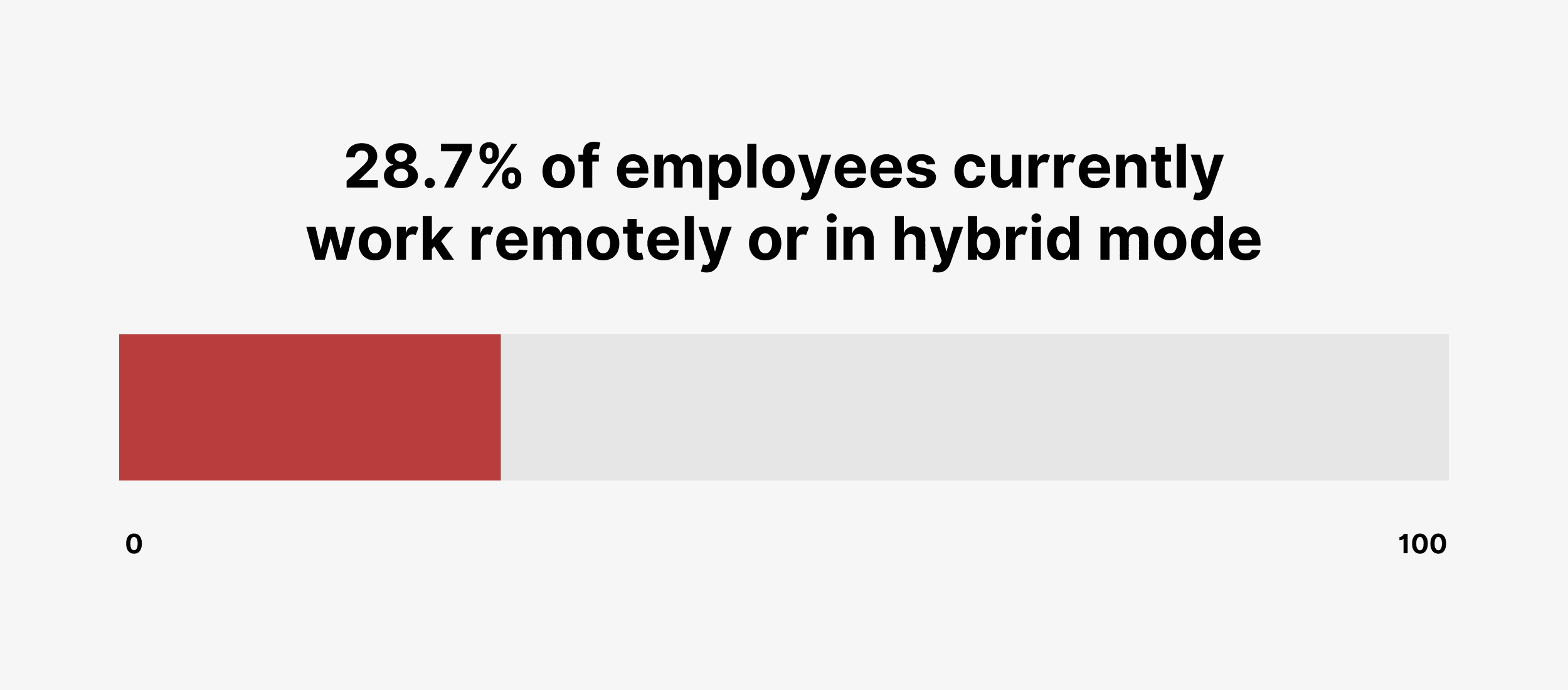
According to a survey of around 1500 business executives at US firms, senior management reports that 7.8% of their full-time employees work fully remotely, while another 20.9% are in hybrid mode.
Here’s a detailed breakdown of the share of full-time employees by work location:
| Category | 2018 | 2023 | 2025 |
|---|---|---|---|
| On-site | 91.6% | 75.7% | 71.3% |
| Hybrid | 4.1% | 14.1% | 20.9% |
| Fully remote | 4.3% | 10.2% | 7.8% |
Finance and insurance have the largest share of remote workers (Survey of Working Arrangements and Attitudes)
30% of full-time employees in finance and insurance work fully remotely, more than in any other industry.
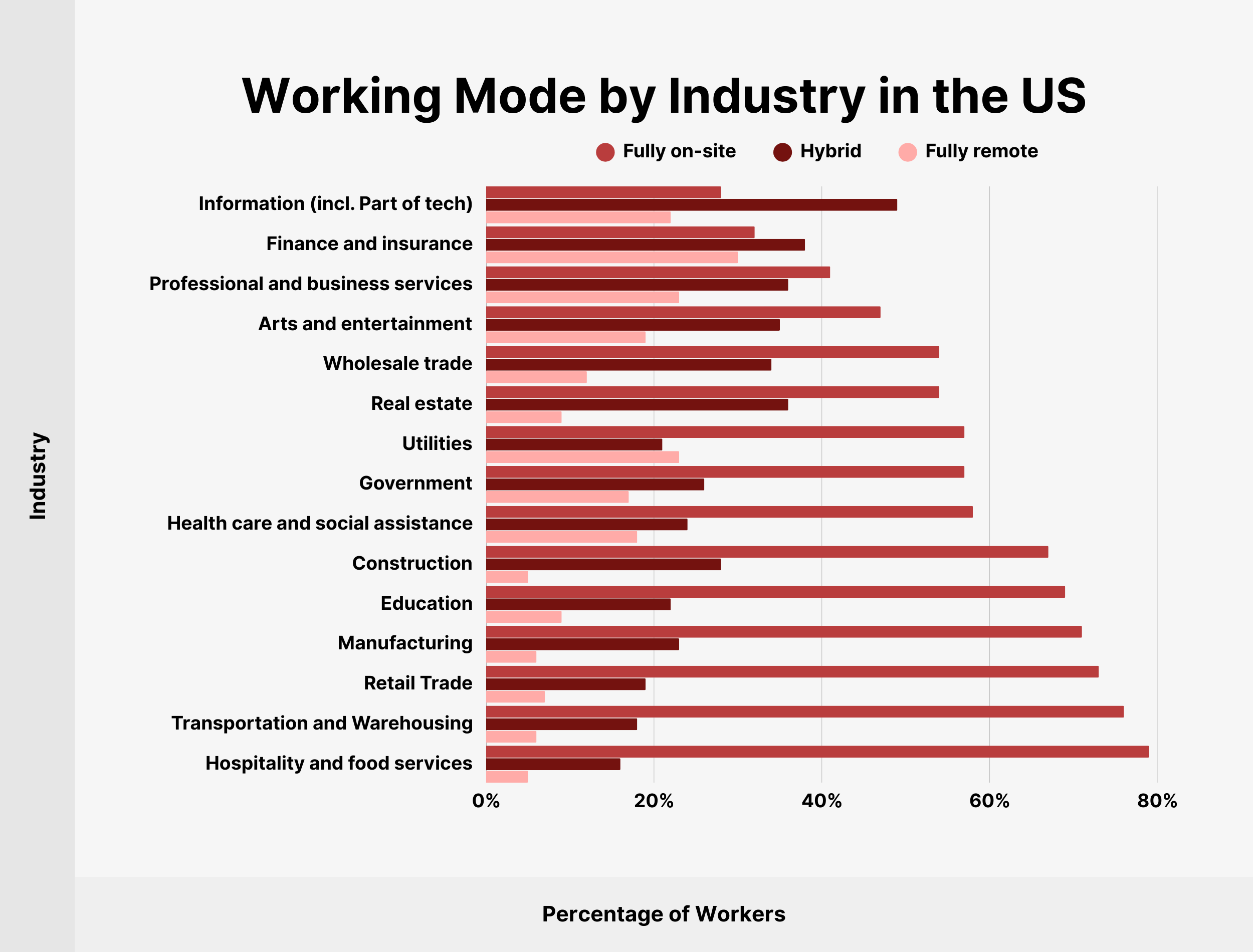
Here’s a detailed breakdown of the share of working mode by industry in the US:
| Industry | Fully on-site | Hybrid | Fully remote |
|---|---|---|---|
| Information (incl. Part of tech) | 28% | 49% | 22% |
| Finance and insurance | 32% | 38% | 30% |
| Professional and business services | 41% | 36% | 23% |
| Arts and entertainment | 47% | 35% | 19% |
| Wholesale trade | 54% | 34% | 12% |
| Real estate | 54% | 36% | 9% |
| Utilities | 57% | 21% | 23% |
| Government | 57% | 26% | 17% |
| Health care and social assistance | 58% | 24% | 18% |
| Construction | 67% | 28% | 5% |
| Education | 69% | 22% | 9% |
| Manufacturing | 71% | 23% | 6% |
| Retail Trade | 73% | 19% | 7% |
| Transportation and Warehousing | 76% | 18% | 6% |
| Hospitality and food services | 79% | 16% | 5% |
Around 10% of job postings in the US offer remote or hybrid work (WFH Map)
As of December 2024, 10.32% of new job postings in the US mentioned the possibility of remote or hybrid work in the job description.
Advertised remote or hybrid work significantly varies by city in the US. For instance, 21.77% of job postings in San Francisco, California mention remote or hybrid work, while in Miami, Florida that’s only a 4.66% share.
Remote Work Preferences
36% of US employees would prefer to work fully remote given the choice, more than any other work model (YouGov)

When asked about preferred work mode, 36% of survey respondents claim to prefer working from home every day, followed by hybrid mode (28%) and working from the office every day (27%).
64% of remote workers say they’re very likely to look for job opportunities with another employer provided no remote flexibility in the future (Gallup)
A significant 64% of remote-only employees claim they are very likely to pursue other job options should they be denied the option of remote work flexibility.
Employee engagement is highest among employees who work fully remotely (Gallup)

Recent research shows that hybrid employees tend to report higher employee engagement than those working on-site (36% feel engaged vs. 33%).
Here’s a detailed breakdown by working mode among US full-time employees:
| Working Mode | Share of Engaged Employees |
|---|---|
| Exclusively remote | 32% |
| Hybrid | 36% |
| On-site (remote-capable) | 33% |
| On-site (non-remote-capable) | 27% |
Remote Work Benefits and Challenges
Over half of remote workers in the US claim working from home helps them with work-life balance and meeting deadlines (Pew Research Center)
71% of US teleworkers say working from home helps with balancing work and personal life.
Over half (56%) of those who work remotely at least occasionally claim that this work arrangement supports their ability to accomplish tasks and meet deadlines.
35% of remote workers say they’re “very engaged” in their job (Buffer)

The recent survey indicates that 58% of remote workers say they’re at least “somewhat engaged” toward their job, including 35% who claim they’re “very engaged”.
Another 30% of employees working from home say they’re at least “somewhat unengaged”.
| Engagement | Share of Remote Workers |
|---|---|
| Very engaged | 35% |
| Somewhat engaged | 23% |
| Neither engaged nor unengaged | 12% |
| Somewhat unengaged | 16% |
| Very unengaged | 14% |
Flexibility stands out as the most significant benefit of remote work (Buffer)
22% of remote workers consider the greatest benefit of remote work to be the flexibility in managing their time, while 19% value the ability to choose where to live, and 13% appreciate the option to select their work location.
21% of remote workers claim that their biggest struggle is that they stay at home too often (Buffer)
When it comes to the biggest struggle with remote work, 21% cite that they stay at home too often, while 15% say that’s loneliness, and 14% report working across time zones.
Remote workers report no commute and savings on gas and lunch costs among the top benefits of working from home (Global Survey of Working Arrangements and Attitudes)
Among surveyed workers who had remote work experience, 51.4% of respondents report “no commute” as a top benefit of working from home, followed by “savings on gas and lunch costs” (44.4%), “flexible work schedule” (38.4%).
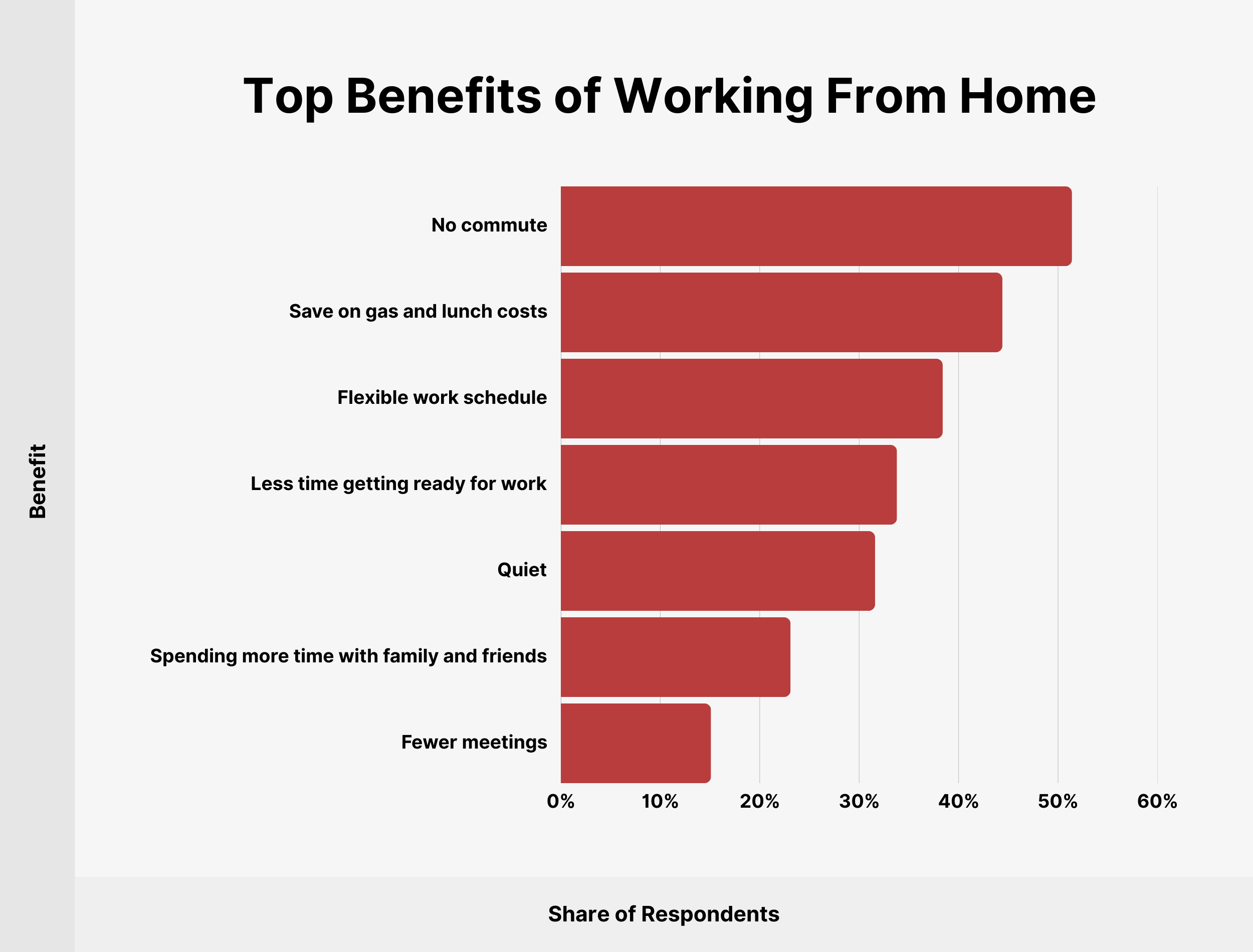
Here’s a complete list of the top benefits of working from home according to workers:
| Benefit | Share of Respondents |
|---|---|
| No commute | 51.4% |
| Save on gas and lunch costs | 44.4% |
| Flexible work schedule | 38.4% |
| Less time getting ready for work | 33.8% |
| Quiet | 31.6% |
| Spending more time with family and friends | 23.1% |
| Fewer meetings | 15.1% |
Backlinko is owned by Semrush. We’re still obsessed with bringing you world-class SEO insights, backed by hands-on experience. Unless otherwise noted, this content was written by either an employee or paid contractor of Semrush Inc.

